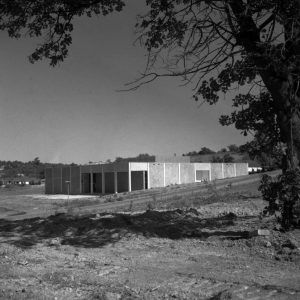calsfoundation@cals.org
William Fewell "Casey" Laman (1913–2012)
William Fewell “Casey” Laman exerted a vigorous—albeit dictatorial—style of leadership during his sixteen-and-a-half-year reign as mayor of North Little Rock (Pulaski County). Serving four terms from 1958 through 1972, and the balance of an unfilled mayoral term from 1979 through 1980, he modernized one of the state’s most populous cities by directing millions of federal, state, and local dollars for housing, education, recreation, and infrastructure.
Casey Laman was born on October 20, 1913, on a farm north of Jacksonville (Pulaski County) to James Newton Laman and Anna Fewell Laman; he had two siblings. His father was a machinist-helper for the Missouri Pacific Railway Company and later opened a furniture store and served as an alderman in North Little Rock, where the family moved when Laman was five. Laman, who got his nickname “Casey” as a child because he loved to hear his father play the “Ballad of Casey Jones” on guitar, attended North Little Rock public schools and graduated from the city’s high school in 1930. After going to Little Rock Junior College for two years and working part time as a soda jerk at Argenta Drug Store, he spent his junior year at the University of Arkansas (UA) in Fayetteville (Washington County). However, financial hardship during the Great Depression forced Laman to drop out of college temporarily, so he returned to the family furniture store.
In 1933, he married Arlene Ellis, his childhood sweetheart from the Baring Cross neighborhood; they had one daughter. Resuming his studies during summer sessions and one full school year in 1938–39, he earned a BS in botany and chemistry from UA in May 1939. Back home, he worked as a deputy assessor for Pulaski County until being drafted into the U.S. Army Air Forces in 1943 during World War II. Although he did not go overseas, he trained as a radio operator, mechanic, and gunner on B-17 airplanes and left the military in 1946.
Assuming management of his father’s furniture store in 1947, Laman also turned his attention to public service. He was appointed a member of North Little Rock’s first library board and served three terms on the North Little Rock School Board from 1949 through 1958.
Laman’s first major initiative upon taking office as mayor in 1958 was a $2 million street paving program. During his first two terms, he also gained voter approval for six bond issues, totaling $11.8 million, to renovate the city’s electrical distribution system and sewer facilities, to purchase the privately owned water system on the north side, and to build a new police station and jail, as well as new fire stations, a new library (named for Laman), and a new city health clinic.
A fierce advocate for North Little Rock, Laman quarreled with Arkansas Department of Transportation officials over the proposed route for Interstate 40, which cut through Burns Park. In exchange for highway right-of-way, the state agreed to pay the city’s outstanding debt on acquisition of the 1,570-acre park from the federal government. Laman supported construction of ball fields, a golf course, a tennis center, and many other recreational amenities at Burns Park, making it one of central Arkansas’s top attractions.
During Laman’s administration, North Little Rock participated in the urban renewal movement, wiping out blighted areas but destroying the city’s historic downtown core and, in most instances, failing to revitalize target areas. In public housing, Laman led the way with construction of the state’s first high-rise buildings for the elderly in the mid-1960s. Tapping federal money, he also oversaw development of five recreation centers in the city’s older and less affluent neighborhoods.
Despite his invulnerability in elections, Laman inspired political wrath for his brash, intimidating style. He often feuded with public officials and others in the private sector, and his dispute with federal authorities in 1970 cost the city some $20 million in potential Model Cities grants. Attempts by the city council to curb his power in the early 1970s failed.
While Laman won most of his legal battles, he lost an important case that resulted from the ejection of a North Little Rock Times reporter from a city council meeting. As the losing party in McCord v. Laman (1967), he provided the first test case of the state’s new Freedom of Information Act, which resulted in affirmation of the open meetings law by the Arkansas Supreme Court. In 1964, a judge reprimanded him for using public money to pave private parking lots. A Pulaski County grand jury questioned Laman in 1971 about what he knew of alleged gambling and prostitution but returned no indictment against him.
Laman continued to live in North Little Rock after he sold his furniture business in 1980; he also served as a non-voting member on the city’s Parks and Recreation Commission. He died on April 16, 2012.
For additional information:
Bradburn, Cary. On the Opposite Shore: The Making of North Little Rock. Marceline, MO: Walsworth Pub. Co., Inc., 2004.
Casey Laman File. North Little Rock History Commission, North Little Rock, Arkansas.
Obituary of William F. “Casey” Laman. Arkansas Democrat-Gazette, April 17, 2012, p. 4B.
Reed, Roy. “Interview of William F. [Casey] Laman.” June 14, 2001. David and Barbara Pryor Center for Arkansas Oral and Visual History. Special Collections. University of Arkansas Libraries, Fayetteville, Arkansas. Online at http://pryorcenter.uark.edu/projects/Arkansas%20Memories/LAMAN-William-F/transcripts/LAMAN-William-F-Memories-20010614.pdf (accessed January 26, 2023).
Sandlin, Jake. “NLR’s Modernizing Mayor Laman Dies.” Arkansas Democrat-Gazette, April 17, 2012, pp. 1B, 3B.
Cary Bradburn
North Little Rock History Commission
 McCord, Robert S.
McCord, Robert S. World War II through the Faubus Era, 1941 through 1967
World War II through the Faubus Era, 1941 through 1967 Laman Library
Laman Library 



Comments
No comments on this entry yet.